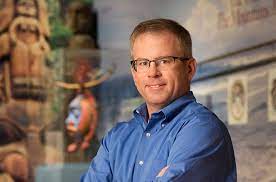Affiliation: Denver Museum of Nature and Science

Stephen E. Nash is the Director of Anthropology and Senior Curator of Archaeology at the Denver Museum of Nature and Science, and was previously Head of Collections of the Department of Anthropology at the Field Museum. He received his Ph.D. and M.A. in Anthropology from the University of Arizona. He has written and edited seven books and dozens of peer-reviewed articles on subjects ranging from Neanderthal stone tools to tree-ring dates, the history of museums to Southwestern archaeology. He has published nearly 40 Curiosities columns for the SAPIENS online magazine, on topics ranging from ancient Roman hygiene to Leonardo da Vinci, and from the Huey helicopter to the use of GPS systems.
The Native American Graves Protection and Repatriation Act of 1990 (NAGPRA) outlines a legal process by which federally recognize Native American tribes could reclaim their ancestors, sacred objects, and communally-owned objects from museums. At that time, many museum employees, bioarchaeologists, and archaeologists were afraid that NAGPRA constituted an existential threat to museums. In the three decades since, NAGPRA has been slow to take hold (for a variety of reasons) and only about 30% of the Native American ancestors have been repatriated. This lecture examples the repatriation movement in archaeology with a specific emphasis on the Denver Museum of Nature & Science, which is a recognized world leader in these efforts.
Short bibliography and/or website on lecture topic:
A recent “Curiosities” post on the topic at SAPIENS.org: https://www.sapiens.org/column/curiosities/vigango-repatriation/
Colwell, Chip, and Stephen E. Nash, 2020. Why We Repatriate: On the Long Arc Towards Justice at the Denver Museum of Nature & Science. In Working with and for Ancestors: Collaboration in the Care and Study of Ancestral Remains, edited by Chelsea Meloche, Laure Spake, and Katherine Nichols. Vancouver: University of British Columbia Press, pp. 79-90.
Nash, Stephen E., and Chip Colwell, 2020. NAGPRA at 30: The Effects of Repatriation. Annual Review of Anthropology 49-225-239.
“The purpose of anthropology is to make the world safe for human differences”, wrote Ruth Benedict in the 1930s. In this spirited, whimsical, and lavishly illustrated lecture, I use archaeological and anthropological findings, discoveries, and theories to examine and critically evaluate modern American culture in 2021. Far from being “normal” in any meaningful sense, we exist in a unique moment in human history. What does that moment really look like when seen through the lens of 200,000 years of human history?
Archaeologists first defined the “Mogollon” culture of mountain regions of Arizona and New Mexico in the 1930s. This lecture examines the history of Mogollon archaeology with specific reference to work performed by the Field Museum of Natural History (Chicago) in New Mexico and Arizona from 1939 to 1972. That history then sets the stage for the presentation of recent research by the Denver Museum of Nature & Science, including the excavation of a mysterious, isolated, and arguably failed ceremonial structure (a great kiva) near Reserve, New Mexico.
Dendrochronology, or tree-ring dating, burst onto the archaeological scene in 1929. In the nearly 100 years since, archaeologists have made extensive use of this dating technique, such that the American Southwest is one of the best dated archaeological regions in the world. Tree-ring dates must not be accepted without question, however. They must be critically evaluated in their archaeological contexts, just like all archaeological data. This lecture examines a large (ca. 20,000 date) tree-ring date distribution from across the American Southwest, particularly with an emphasis on the history of research in the region. In so doing, we identify strengths and on-going challenges for our interpretation of what happened at places like Mesa Verde, Chaco Canyon, and other wonderful sites.
Mesa Verde National Park has served as a laboratory for dendrochronology, or tree-ring dating, since the 1920s.The archaeological sites contained within the Park include some of the best dated pre-Columbian sites in the world. In spite of this rich record of archaeological dates, some mysteries remain. In 1965, archaeologists working on Wetherill Mesa thought they had discovered, at a place called Schulman Grove, dendrochronological evidence for prehistoric cultivation and manipulation of trees harvested for the construction of cliff dwellings at Mesa Verde. My colleagues and I recently used tree-ring and archival analysis to test their assertions with a critical eye. This lecture shares the results of that research.
Short bibliography and/or website on lecture topic:
A recent “Curiosities” post on the topic at SAPIENS.org: https://www.sapiens.org/column/curiosities/mesa-verde-ancestral-puebloan/
Nash, Stephen E., Ronald H. Towner, and Jeffrey S. Dean. The Curious Case of Schulman Grove, Mesa Verde National Park, Southwestern Colorado, USA. American Antiquity, July 2021.